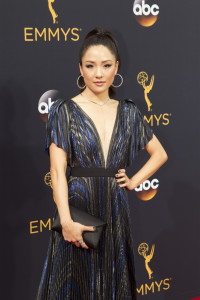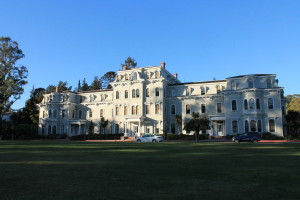
As pictures of art flowed across the screen, lecturer Margo Machida carefully unpacked each artist’s intention in her talk “Trans-Pacific Visions: Islands and Oceanic Imaginaries in Asian American Art. ”
On Oct. 20, the art and art history departments hosted Machida as the latest speaker in The Jane Green Endowment for Studies in Art History and Criticism lecture series.
Mary-Ann Milford, head professor of art history, invited Machida to speak in the series, calling Machida’s work “deep” and “rigorous.”
“She’s done so much to promote Asian Americans in the broadest term,” Milford said. “She, tonight, introduced us to artists that I was not aware of.”
Jane Green, the Mills alumna who started the lecture series, agreed. When she donated to Mills’ art department, she wanted to create something that would enhance the art program. Each art professor will get to invite a speaker whose work is usually integrated into the professor’s curriculum.
“I thought she did an incredible job,” Green said. “Often Asian work relates to the family and diaspora of the family…I saw work I’d never seen before.”
Machida has worked on compiling Asian art that transcends borders with themes that connect artists in different countries. She published a book in 2009 titled “Unsettled Visions: Contemporary Asian American Artists and the Social Imaginary.” Now, she works at the University of Connecticut as professor of art history and Asian American studies as well as being the associate editor of the international journal Asian Diasporic Visual Cultures and the Americas and co-editor of the 2017 special issue, “Island Worlds, Oceanic Diasporas, and Global Flows.”
Machida was born and raised in Hawai’i. This nurtured her interest in Asian American art and the connectivity of islands because Hawai’i is situated between Asia and the Americas.
“Islands function as ideas of resistance,” Machida said. “Identity at whatever level is somewhat of a catalyst.”
Machida opened by giving background on the development of Asian American and indigenous people’s art throughout history and into the contemporary scene. She then dove into the ways in which the different artists connected to history and heritage through political art statements.
“The main thing is to get a sense of the breadth of Asian American issues,” Machida said. “To portray a broader, more fluid picture.”
The fourteen artists Machida presented ranged from photographers to sculptors, painters to mixed-media artists – all exploring identity through historical, political or social contexts. Machida clarified that this exploration of identity can be controversial, as Asian American art is often looked at in terms of domestic, U.S. focused work, and she wanted to view it in a different way.
“There’s so much controversy over identity politics,” Machida said. “A lot of the work we’re looking at is in the trans-national frame.”
Works from the fourteen artists commemorated, addressed, interpreted or brought attention to various moments in historical contexts. Michael Arcega’s “Mothership-2“ traces trans-oceanic routes and ties into the Arab Spring demonstrations. Mona Higuchi’s “Relocation: Alaska 1942-45“ centered on the relocation of the Unangan People (Aleuts) during WWII. Weston Teruya’s “From a land of low-lying clouds (18+18)” explores diasporic Hawaiian experiences.
The effects of colonization appear in some of the artists’ work. In Vernon Ah Kee’s “Can’t Chant,” he uses the symbolism of surf boards to show how hard it is for Aboriginal people to enter into Australia’s surf culture. He painted the bottoms of the surfboards in the colors of the Aboriginal flag, yellow, red and black, and printed intimate portraits of his relatives onto the boards as well.
Rooted to the exploration of historical stories as the basis for art and the excavation of identity in a multi-faceted way, Beatrice Glow created an installation in a tearoom, “Rhunhattan,” crafting her own Delftware tea set. Instead of the traditional delicate blue that porcelain is usually decorated with, Glow uses a deep red to underscore the stately scene of a tearoom, depicting scenes of violence on the tableware. The scenes show the effects that the tea trade and the spice trade had on a small Indonesian Island. Rhun (also known as Pulau Run) was used to grow nutmeg to feed the Spice Trade, which catalyzed the exploitation of the native peoples. On the other end, Manhattan was home to many stately tea rooms that bought into the trade.
Describing the historical dimension many of the artists held in their pieces, Machida believes that the impulse or impetus that inspires their art often arises from observing local conditions and then opens out.
Machida gave facts about the pieces, and quoted the artists’ motivations, letting the audience come to their own conclusions about the art and how it tied into her bigger theme.
Akari Goda-Maurezzutt, a Mills student, appreciated the details Machida included about each artist.
“She’s very specific,” Goda-Maurezzutt said. “None of it is irrelevant.”



